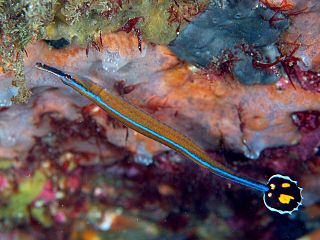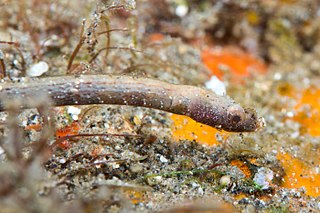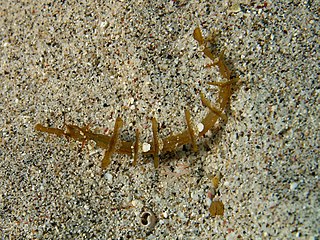
The pennant coralfish, also known as the longfin bannerfish, reef bannerfish or coachman, is a species of fish of the family Chaetodontidae, native to the Indo-Pacific area.

Doryrhamphus and Dunckerocampus, popularly known as flagtail pipefish, are two genera of fishes in the family Syngnathidae. They are found in warm, relatively shallow waters of the Indo-Pacific, with a single species, D. paulus, in the eastern Pacific. Most of these pipefishes are very colourful, and are fairly popular in the marine aquarium hobby despite requiring special care and not being recommended for beginners.

Doryrhamphus is a genus of pipefishes, one of the two genera colloquially known as flagtail pipefishes and are popular in the aquarium trade. The members of this genus are native to the Indian and Pacific Oceans where they inhabit reef environments. The species in this genus have a maximum length of 14 centimetres (5.5 in) or less, with D. janssi being the only species that surpasses 8.5 centimetres (3.3 in). Most species have a horizontal blue line along their body, and all have a whitish-edged tail that is marked contrastingly with black, red or yellow.

Corythoichthys intestinalis, known commonly as the scribbled pipefish, is a species of marine fish in the family Syngnathidae. Other common names used include banded pipefish, Australian banded pipefish, Australian messmate pipefish and messmate pipefish.

The Halimeda ghost pipefish, Solenostomus halimeda, is a species of false pipefishes belonging to the family Solenostomidae.

Taylor's garden-eel is a heteroconger belonging to the family Congridae. It is native to the central Indo-Pacific.

Corythoichthys amplexus, known commonly as the many-spotted pipefish or yellow-spotted pipefish , is a species of marine fish in the family Syngnathidae.

Doryrhamphus excisus is a species of flagtail pipefish from the genus Doryrhamphus. Its common names include blue-striped pipefish and blue-and-orange cleaner pipefish. The fish is found throughout much of the Indo-Pacific and tropical East Pacific.

Doryrhamphus japonicus, or the Honshu pipefish, is a species of flagtail pipefish from the genus Doryrhamphus that occurs in the Western Pacific Ocean, from Milne Bay, Papua New Guinea, to Sulawesi, Indonesia, the Philippines, and north as far as Honshu, Japan and Korea. It is a marine demersal pipefish that inhabits coastal lagoons, rocky and coral reefs, and tidal pools down to as deep as 30 metres (98 ft) but it is unusual below 10 metres (33 ft). This species is frequently found in association with sea urchins of the genus Diadema and with sponges. It is an active cleaner, feeding on parasites found on other fishes. It frequently shares crevices with shrimps, large mud crabs and occasionally moray eels.

Halicampus dunckeri or also commonly known as the Duncker's pipefish or ridgenose pipefish is a species of fish in the family Syngnathidae.

Halicampus macrorhynchus or also commonly known as the ornate pipefish , whiskered pipefish or winged pipefish is a species of fish in the family Syngnathidae.
Hippichthys cyanospilos, commonly known as the blue-spotted pipefish or bluespeckled pipefish, is a marine fish belonging to the family Syngnathidae, native from the Indo-Pacific area.

Choeroichthys brachysoma is a species of marine fish of the family Syngnathidae.
Choeroichthys sculptus, the sculptured pipefish, is a species of marine fish of the family Syngnathidae.
Choeroichthys smithi is a species of marine fish of the family Syngnathidae. It is found in the western Indian Ocean along the coasts of Reunion, Mauritius, the Seychelles, Madagascar, Tanzania, Mozambique, and South Africa. It is a demersal species, inhabiting tide pools and reef flats in coastal waters where it can grow to lengths of 5 cm. This species is ovoviviparous, with males carrying the eggs and giving birth to live young. The specific name honours the South African ichthyologist J.L.B. Smith (1897-1968) who collected the material which was used as the holotype by Dawson when he described the species.

Corythoichthys nigripectus is a species of marine fish of the family Syngnathidae. It is found in the Indo-Pacific, from the Red Sea, Indonesia and the Philippines to the Society Islands, Guam and New Caledonia. It inhabits coral reefs and algae patches at depths of 5–30 metres (16–98 ft), where it can grow to lengths of 11 centimetres (4.3 in). This species is both monogamous and ovoviviparous, with males carrying eggs and giving birth to live young.

Doryrhamphus negrosensis, commonly known as Negros pipefish, flagtail pipefish, Masthead Island pipefish or Queensland flagtail pipefish, is a species of marine fish of the family Syngnathidae. It is found in the Western Pacific Ocean, from Borneo to Vanuatu and the Yaeyama Islands to the Rowley Shoals and the Great Barrier Reef. It lives in mud flats and reefs, both coral and rocky, where it is often associated with sea urchins. It is a rather solitary species which may be found in pairs or small groups. It inhabits depths to 9 metres (30 ft), and can grow to lengths of 6.2 centimetres (2.4 in). Although little is known of its feeding habits, it is expected to feed on harpacticoid copepods, gammarid shrimps, and mysids, similar to other pipefish, it may also act as a cleaner fish like other species in the genus Doryrhamphus. This species is ovoviviparous, with males carrying eggs before giving birth to live young. Males may brood at 4.3 cm. It is a small bluish to bluish-grey pipefish which has a pale stripe along the dorsal side of the head and snout, and a dark fan-like caudal fin which has white margins and an orange base.

Dunckerocampus pessuliferus, occasionally Doryrhamphus pessuliferus, is a species of marine fish of the family Syngnathidae. It is a coastal species, inhabiting waters around the Coral Triangle, including the Philippines, Indonesia, and northwestern Australia. It lives in coral patches on sandy and muddy slopes at depths of 15–44 metres (49–144 ft), where it can grow to lengths of 16 centimetres (6.3 in). It is an active cleaner, feeding off of parasitic crustaceans growing on other fishes. The adult fish form pairs and are normally observed swimming along the bottom around large remote coral heads on muddy slopes. This species is ovoviviparous, with males carrying eggs and giving birth to live young.

The beady pipefish is a species of pipefish of the family Syngnathidae. It is found in the Indo-West Pacific, from the western Persian Gulf, to the north central Indian Ocean, to Japan and Australia. It lives in the lower parts of streams and rivers, estuarine habitats such as seagrass beds and mangroves, and shallow inshore habitats, where it can grow to lengths of 16–18 centimetres (6.3–7.1 in). It is expected to feed on small crustaceans, similar to other pipefish. This species is ovoviviparous, with males carrying eggs in a brood pouch before giving birth to live young. Average brood size is 177.
Hippichthys spicifer, commonly known as bellybarred pipefish, banded freshwater pipefish, or blue spotted pipefish, is a species of pipefish of the family Syngnathidae. It is found in the Indo-Pacific, from the Red Sea and East Africa to Sri Lanka and Samoa. It lives in shallow coastal and estuarine habitats such as mangroves, tidal creeks, and the lower reaches of rivers, where it can grow to lengths of 18 centimetres (7.1 in). It is expected to feed on small crustaceans and mosquito larvae. This species is ovoviviparous, with males brooding eggs in a brood pouch before giving birth to live young. It is reproductively active all year, with males and females reaching sexual maturity at 10.8 and 10 centimetres respectively. Brood size can vary significantly, from 114 to 1764, with an average of 604.4 plus or minus 322.8.














